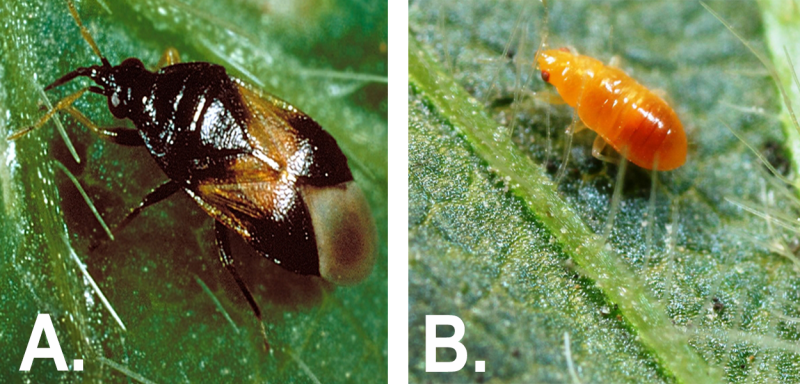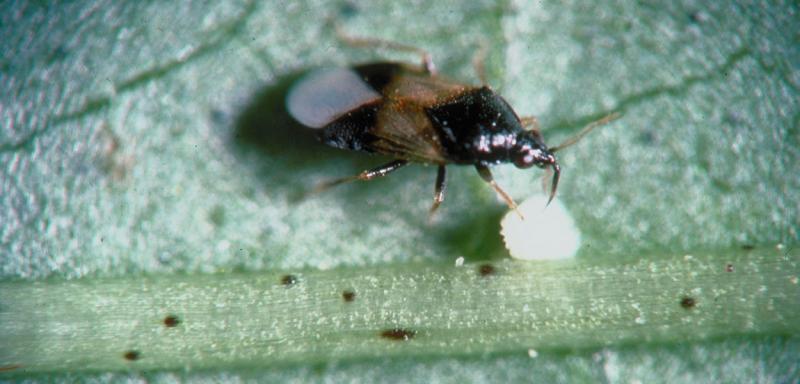Written with contributions by Shelby Pritchard, former SDSU Extension Pest Management Specialist.
Originally Submitted: May 19, 2022
Minute pirate bugs (or insidious flower bugs) are sometimes viewed as a nuisance due to the annoying and painful pinch-like bites they occasionally inflict on humans. However, this behavior only occurs late in the season after their more typical prey is no longer available. During the growing season, minute pirate bugs are not normally noticed due to their small size and activity within the plant canopies. Minute pirate bugs are beneficial insects, because they prey upon numerous arthropod pests of both garden and agricultural crops.
Life Cycle and Identification

Adult minute pirate bugs are approximately 1/10 of an inch long and oval-shaped. They have a black head and thorax, brown patch in the middle of their body, and wing tips that appear white in color (Figure 1-A). Minute pirate bugs belong to the family Anthocoridae within the order Hemiptera (true bugs). True bugs all have piercing-sucking mouthparts.
In South Dakota, minute pirate bugs overwinter as adults in protected areas, such as leaf litter. Adults emerge in spring and live approximately 35 days. Once appropriate habitat has been found, the adults mate, and females begin to lay individual eggs into plant tissue. Females can lay around 100 eggs during their lifetime.
Depending on the weather, larvae begin to emerge after five days. Larvae are small, oval-shaped, wingless and have red eyes (Figure 2-B). They molt five times and are very small (up to 1/100 of an inch long). The first larval instar is yellow in color, with each additional instar becoming darker. The final instar is mahogany in color. Several generations of minute pirate bugs are possible throughout the growing season in South Dakota.
Feeding Behavior

Both nymphs and adults use their piercing-sucking mouthparts to prey upon soft-bodied insects and eggs (Figure 2). They are a generalist predator, because they feed on multiple pest insects, including aphids, spider mites, thrips, leafhopper nymphs, corn earworm eggs, whiteflies and small caterpillars. However, they will destroy more prey than they consume by targeting multiple prey in an area. When prey is scarce, minute pirate bugs will feed on plant pollen and juices. Such feeding does not cause significant injury to the plants and has never been linked to yield loss. Minute pirate bugs have also been used in greenhouses as generalist predators.
Management
Minute pirate bugs are common in agricultural fields, especially soybean. In the fall, as these crops are harvested, minute pirate bugs move out of the fields and can end up in residential areas. If they land on people, they may bite in defense or because they are looking for a food source. They are not blood feeders, and their bites are simply a nuisance and do not require treatment. As mentioned previously, minute pirate bugs are a beneficial insect and provide biological pest control in both garden and agricultural settings. Therefore, no management is recommended.


